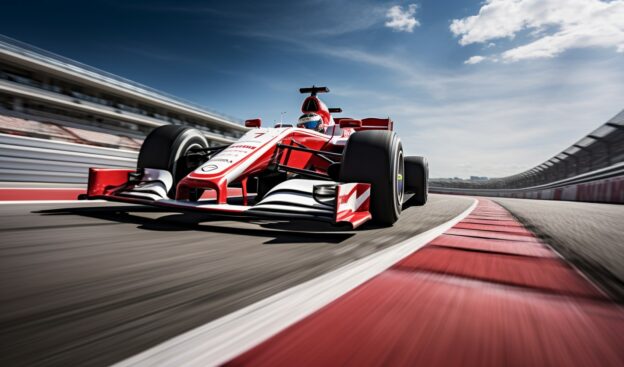The Toughest Tracks in Formula 1's Storied History

Formula 1 racing is much more than just a display of speed; it's a grand stage where the mastery of driving finesse, the daring dance with danger, and the relentless chase for perfection play out lap after lap. The glorious saga of Formula 1 is not just about the drivers or the cutting-edge machines they command; it’s equally about the tracks that lay down the tarmac for these high-speed chariots.
The Las Vegas Parking Lot Fiasco
Las Vegas, the world-renowned haven for gamblers and thrill-seekers, holds a peculiar page in the story of Formula 1. The chronicle unfolds in 1981 as the cavalcade of Formula 1 meandered into the illustrious city of lights. Yet, a deviation from the norm awaited, for instead of vying on a customary circuit, the spectacle was destined to transpire amidst the asphalt expanse of the Caesars Palace Hotel's parking lot.
The improvised track was a far cry from the usual F1 circuits, lacking the character and challenge that drivers and fans had come to expect. The layout was tight, twisty, and devoid of any elevation changes, making it more akin to a go-kart track than a stage for the pinnacle of motorsport.
The venture to bring F1 into the heart of the casino capital was a gamble that didn’t pay off. The juxtaposition of elite motorsport racing and casino glitz piqued interest but lacked the substance to create a lasting legacy. The event dwindled after just two years, leaving behind lessons about the essence of a genuine racing ambiance that a makeshift parking lot circuit could never emulate.
However, it wasn't all a bust; the event spotlighted Las Vegas's vibrant casino culture. Even if the track failed to make a mark, the city's casinos continued to thrive as the world's offline gambling capital. And now, with the advent of online casinos, the thrill of gambling has been brought into enthusiasts' homes. For those seeking a slice of Vegas excitement without leaving their cozy sofas, it is now not only easy to access any online casino in the world, but also to claim free https://polskiesloty.com/darmowe-spiny/ upon registration without requiring a deposit.
The German AVUS '59
The AVUS circuit, which stands for Automobil-Verkehrs- und Übungsstraße, was a spectacle. Enshrined within Germany's core, this circuit bore witness to renown and notoriety. The Grand Prix 1959, harbored here, emerged as an epochal event, etching an indelible imprint upon the motorsport fraternity.
The notorious high-speed track was, in essence, a stretch of autobahn, which in 1959 morphed into a fearsome battleground for the Grand Prix. The AVUS’s North Curve was a perilous steep banking, pitched at an intimidating 43-degree angle. The cars hurtled down the straights at breakneck speeds only to be caught in a gravitational duel as they negotiated the banked curve.
That year, the race was marred by a catastrophic crash involving driver Jean Behra. The daredevilry required to tame the AVUS was epitomized in that tragic incident, shedding light on the fine line between glory and calamity that F1 drivers tread.
The Road Courses: Detroit and Dallas
Amid the mixed bag of tracks in Formula 1’s history, the road courses in Detroit and Dallas stand out for their unique challenges.
- Detroit Grand Prix Circuit (1982-1988): The Detroit circuit was a concrete maze snaking through the city’s streets. Its bumpy surface and tight, twisting layout demanded precision driving and exceptional car control.
- Fair Park Circuit, Dallas (1984): The Dallas Grand Prix was a one-off event that etched its name into F1 lore for the extreme conditions it presented. The blistering warmth of the Texan summer wreaked havoc on the track's surface, causing it to fragment and pose a formidable challenge to the drivers.
With their scant run-off areas and the exigent nature of street racing, these road courses manifested a stark antithesis to the purpose-built tracks. The narrow confines and the unyielding, bumpy ride afforded no margin for error, rendering every lap a high-stakes endeavor.
The Modern Challenge: Qatar
As Formula 1 persevered in expanding its global imprint, it embarked on uncharted territories, one of which was the sovereign state of Qatar. The inception of the Losail International Circuit on the F1 itinerary introduced fresh challenges. The circuit, celebrated for its nocturnal races amidst the glow of countless illuminations, disclosed a modern-day trial for the drivers, teams, and orchestrators.
The desert ambiance of the circuit ushered in a distinctive set of conditions. Sand from the surrounding desert often found its way onto the track, making grip levels slippery. Besides, the extreme heat tested man's and machine's endurance even after sunset.
Conclusion
The odyssey of Formula 1, traversing decades and continents, has witnessed races on a diverse spectrum of tracks, each possessing its distinct persona and challenges. The sport has incessantly evolved from the high-velocity peril of the AVUS in Germany to the ill-advised parking lot race in Las Vegas, from the relentless street circuits of Detroit and Dallas to the modern-day trials in Qatar. With their varied trials, these tracks have scrutinized the resilience of the drivers and teams and catalyzed innovations within the sport.
✅ Check out more posts with related topics:












